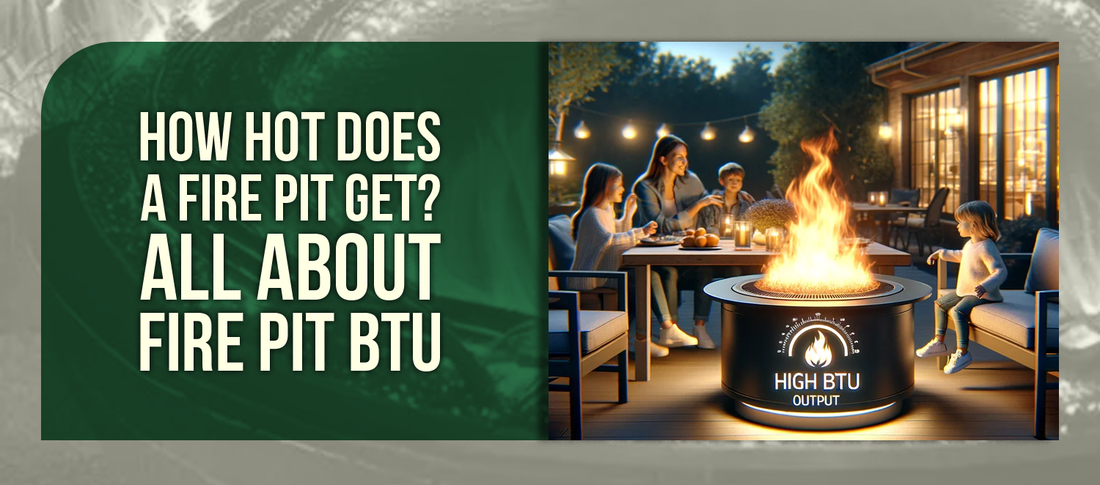
How Hot Does a Fire Pit Get? All About Fire Pit BTU
Master the science of fire pit heat output with our comprehensive guide to BTU ratings, temperature ranges, and fuel efficiency for optimal outdoor warmth
Understanding Fire Pit Heat Output
Fire pit temperature varies dramatically based on fuel type, design, and airflow conditions. Gas fire pits typically reach 400-1000°F, while wood-burning pits can exceed 2000°F at peak combustion. BTU ratings help compare heat output across different models and fuel sources.

Key Takeaways
Essential facts about fire pit temperatures and BTU ratings for informed purchasing decisions
Temperature Ranges
Wood fire pits reach 1500-2000°F in the combustion zone, while gas models typically operate between 400-1000°F. Propane fire pits offer consistent heat output, making them ideal for predictable warmth and cooking applications.
BTU Significance
British Thermal Units measure heat output per hour. Higher BTU ratings indicate more heat production, but efficiency and design affect actual warmth distribution. Consider BTU per square foot for accurate heating capacity assessment.
Fuel Efficiency
Different fuels offer varying heat outputs and burn characteristics. Natural gas provides consistent BTU ratings, propane offers portability, while wood delivers maximum heat but requires active management for optimal performance.
What Factors Determine Fire Pit Heat Output?
Multiple variables influence how much heat your fire pit produces and distributes
Fire Pit Heat Output Comparison
Airflow and Oxygen Supply
Proper ventilation dramatically affects combustion temperature and efficiency. Well-designed fire pits with adequate air circulation achieve higher temperatures and cleaner burns, maximizing heat output while minimizing smoke production.
Fuel Quality and Type
Seasoned hardwoods like oak and maple produce higher BTU outputs than softwoods. Gas quality, pressure settings, and burner design significantly impact temperature consistency and overall heat distribution patterns.
Fire Pit Design and Size
Bowl depth, wall thickness, and material composition affect heat retention and radiation. Larger fire pits accommodate more fuel but may not necessarily produce higher temperatures than well-designed smaller models.
Fire Pit BTU Rating
Understanding BTU measurements helps you choose the right fire pit for your heating needs
BTU Rating Guidelines
Small Patios (Under 100 sq ft)
15,000-30,000 BTU provides adequate warmth for intimate spaces and small gatherings
Medium Areas (100-200 sq ft)
30,000-50,000 BTU suitable for standard patios and moderate-sized entertaining areas
Large Spaces (200+ sq ft)
50,000+ BTU necessary for expansive outdoor areas and large group gatherings
Wind Considerations
Exposed locations require 25% higher BTU ratings to compensate for heat loss from wind
BTU vs. Actual Heat Output
Higher BTU ratings don't always translate to more perceived warmth. Fire pit design, heat distribution, and local wind conditions significantly impact how much heat reaches seating areas. Consider these factors alongside raw BTU numbers when selecting a fire pit.
Types of Fire Pit Fuel and Heat Output
Compare different fuel options and their heating characteristics
Natural Gas
Clean burning with consistent BTU output. Typically 30,000-60,000 BTU per hour. Requires permanent gas line installation but offers convenient operation.
Propane
Portable option delivering 40,000-80,000 BTU from standard tanks. Higher heat output than natural gas with easy tank replacement and portability benefits.
Wood Burning
Traditional choice producing up to 90,000 BTU with proper seasoned hardwood. Variable output depending on wood type, moisture content, and airflow management.
Bioethanol
Eco-friendly alcohol-based fuel producing 10,000-20,000 BTU. Clean burning with no smoke, perfect for enclosed spaces and environmentally conscious users.
Wood Burning Fire Pit Temperatures
Understanding wood fire behavior and temperature management
Temperature Phases
Wood fires progress through distinct temperature phases. Initial ignition reaches 500-700°F, active combustion peaks at 1500-2000°F, while coaling stage maintains 800-1200°F. Each phase offers different heating characteristics and cooking opportunities.
Heat Retention Factors
Fire pit materials significantly impact temperature retention. Steel pits heat quickly but cool rapidly, while cast iron and stone retain heat longer after fires die down. Proper material selection extends warming periods and fuel efficiency.
Maximizing Wood Fire Heat Output
Seasoned Hardwood Selection
Use oak, maple, or hickory with less than 20% moisture content for maximum BTU output
Proper Stacking Technique
Build fires with adequate air gaps between logs to promote complete combustion
Optimal Fire Size
Maintain fires sized appropriately for your pit to prevent heat loss and safety issues
Wind Management
Position seating to take advantage of prevailing winds for optimal heat distribution
Propane Fire Pit Heat Output
Propane fire pits offer reliable, controllable heat for consistent outdoor comfort
Instant Heat Control
Propane fire pits provide immediate temperature adjustment through gas valve controls. Achieve desired heat levels instantly without waiting for wood to catch fire or coals to develop, perfect for spontaneous outdoor gatherings.
Fuel Efficiency
Standard 20-pound propane tanks provide 8-12 hours of operation at medium settings. Higher BTU models consume fuel faster but deliver more heat, making propane cost-effective for regular use and predictable runtime planning.
Consistent Output
Unlike wood fires that fluctuate in temperature, propane maintains steady heat output throughout operation. This consistency makes propane ideal for cooking applications and maintaining comfortable temperatures for extended periods.

How to Choose the Right BTU Rating for Your Fire Pit
Select appropriate heat output based on your specific outdoor space and usage needs
BTU Selection Criteria
Space Measurement
Calculate your outdoor area square footage and allow 100-150 BTU per square foot for adequate heating
Climate Considerations
Colder regions require higher BTU ratings, while milder climates can use lower outputs effectively
Usage Patterns
Consider whether you'll use the fire pit for ambiance, serious heating, or cooking applications
Group Size Planning
Larger gatherings need higher BTU ratings to warm extended seating areas effectively





